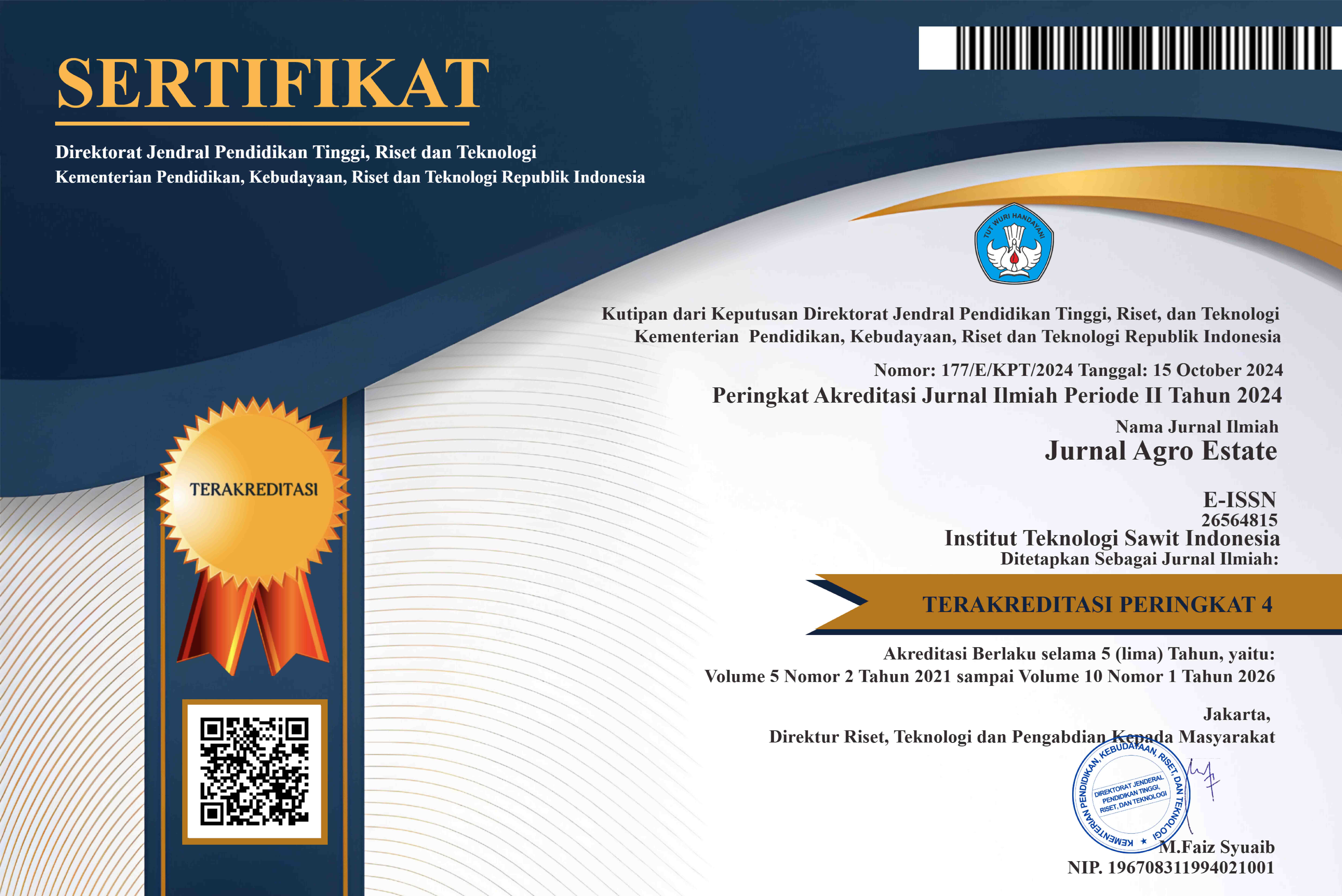STRATEGI PENANGANAN BERCAK DAUN CURVULARIA SP. PADA PEMBIBITAN KELAPA SAWIT DI INDONESIA
DOI:
https://doi.org/10.47199/jae.v7i2.201Keywords:
Palm Oil, leaf spot, Curvularia sp, management strategyAbstract
Oil palm (Elaeis guineensis Jacq) is one of the plantation crops that produces vegetable oil which has become the main ingredient and leading agricultural commodity in Indonesia. The quality of oil palm seedlings is a disease attack during the seedling stage. The most common disease found in oil palm nurseries is leaf spot disease. The aim of this research is to propose strategies for handling leaf spot in oil palm nurseries in Indonesia. This research is a literature study research. The data used comes from secondary data. Data collection methods use textbooks, journals and periodical. Data analysis is carried out by reading, collecting, citing information, concluding and interpreting the results obtained through relevant study materials. The results obtained that there are several strategies that can be used to treat leaf spot in oil palm nurseries in Indonesia, i.e. by carrying out photon energy irradiation which can increase plant resistance to various types of pathogens, developing organic fertilizer formulations and using biocontrol agent which is expected to help oil palm nurseries in suppressing leaf spot disease, using fungicides to prevent resistance, taking preventive measures to reduce the risk of spot disease on oil palm leaves, carrying out conservation fertilization using S2 (385 mesh), S3 (638 mesh), and S4 (644 mesh) sachets and applying liquid smoke areca nut in suppressing the growth of Curvularia sp.
Downloads
References
Akhmad Faisal Malik, Tiara Dwi Nurmalita, & Anastastia Raditya Hidayanti, 2022. Efficacy of Microbial Concortia with Liquid Organic Fertilizer for Leaf Spot Disease Control on Oil Palm Nursery. International Journal of Oil Palm, 5(1), 16–25. https://doi.org/10.35876/ijop.v5i1.70
Al Maududy, M. M., Mardianto, K., & Susanto, A, 2021. Pemanfaatan Berbagai Sensor Dalam Manajemen Perkebunan Kelapa Sawit. WARTA Pusat Penelitian Kelapa Sawit, 26(2), 117–123. https://doi.org/10.22302/iopri.war.warta.v26i2.61
Andini, P., Agustinur, A., & Ritonga, N. C., 2022. Kajian Insidensi Penyakit Bercak Daun pada Pembibitan Kelapa Sawit di Main Nursery PT. Socfindo Kebun Seunagan. Biofarm : Jurnal Ilmiah Pertanian, 18(2), 68. https://doi.org/10.31941/biofarm.v18i2.2275
Defitri, Y., 2021. Intensitas dan Persentase Serangan Beberapa Penyakit Utama Pada Tanaman Sawit (Elaeis guineensis Jacq.) di Desa Tebing Tinggi Kecamatan Mara Sebo Ulu Kabupaten Batanghari. Jurnal Ilmiah Universitas Batanghari Jambi, 21(3), 1399.https://doi.org/10.33087/jiubj.v21i3.1761
Haq, I. U., Ijaz, S., Faraz, A., Sarwar, M. K., & Khan, N. A., 2021. First report of Curvularia leaf spot of Chamaedorea seifrizii caused by Curvularia lunata in Pakistan. Journal of Plant Pathology, 103(2), 713. https://doi.org/10.1007/s42161-021-00794-5
Hermawan, S. dan A., 2021. Metode Penelitian Bisnis Pendekatan Kuantitatif dan Kualitatif. Media Nusa Creative.
Kirkman, E. R., Hilton, S., Sethuraman, G., Elias, D. M. O., Taylor, A., Clarkson, J., Soh, A. C., Bass, D., Ooi, G. T., McNamara, N. P., & Bending, G. D., 2022. Diversity and Ecological Guild Analysis of the Oil Palm Fungal Microbiome Across Root, Rhizosphere, and Soil Compartments. Frontiers in Microbiology, 13 (February), 1–15.
https://doi.org/10.3389/fmicb.2022.792928
Kittimorakul, J., Sunpapao, A., Duangpan, S., Anothai, J., & Eksomtramage, T., 2019. Screening of oil palm (Elaeis guineensis Jacq) varieties for resistance to Curvularia leaf spot disease. Australian Journal of Crop Science, 13(4), 507–512.
https://doi.org/10.21475/ajcs.19.13.04.p1276
Lekete, E., Osekre, E. A., & Andoh-Mensah, E., 2022. First Report of Curvularia pseudobrachyspora Causing Leaf Spots Disease on Coconut Seedlings in Ghana. American Journal of Plant Sciences, 13(07), 972–983.
https://doi.org/10.4236/ajps.2022.137064
Mahmud, Y., Lististio, D., Irfan, M., & Zam, S. I., 2021. Efektivitas Asap Cair Tandan Kosong Kelapa Sawit Untuk Mengendalikan Ganoderma Boninese Dan Curvularia Sp. in Vitro. Jurnal Pertanian Presisi (Journal of Precision Agriculture), 5(1), 24–39. https://doi.org/10.35760/jpp.2021.v5i1.3629
Mehta, T., & Meena, M. (n.d.). Bioactive compounds of Curvularia species as a source of various biological activities and biotechnological applications.
Priwiratama, H., Eris, D. D., Pradana, M. G., & Rozziansha, T. A. P., 2023. Status Terkini Penyakit Bercak Daun Kelapa Sawit Di. Warta PPKS, 28(1), 27–38.
Priwiratama, H., Prasetyo, A. eko, & Sujadi., 2017. Gejala, Faktor Pencetus dan penanganan Bercak Daun Curvularia dan Antraknosa di Pembibitan Kelapa Sawit. Warta PPKS, 23(1), 25–34.
Priwiratama, H., & Widiyatmoko, B., 2022. Potensi Teknologi Iradiasi Energi Foton Untuk Pengendalian Penyakit Bercak Daun Curvularia sp. Pada Tanaman Kelapa Sawit. Warta Pusat Penelitian Kelapa Sawit, 27(3), 134–145. https://doi.org/10.22302/iopri.war.warta.v27i3.91
Rahma, A., Wahyuni, M., & Manurung, S., 2019. Efektifitas Pupuk Dalam Beberapa Ukuran Sachet Terhadap Pertumbuhan Bibit Kelapa Sawit (Elaeis guineensis Jacq). Jurnal Agro Estate, 3(2), 80–89. https://doi.org/10.47199/jae.v3i2.97
Santoso, I., Fadhilah, Q. G., Safitri, S. D., Handayani, S., Maryanto, A. E., & Yasman, Y., 2022. Inhibition of the phytopathogenic fungi Curvularia lunata BM and Ganoderma sp. TB4 by antifungal compounds produced by Bacillus siamensis LDR grown on hanjeli (Coix lacryma-jobi L.) starch. Pharmacia, 69(1), 203–210.
https://doi.org/10.3897/pharmacia.69.e80180
Siahaan, M., Arief Setiawan Sutanto, & Sion Calvin Simanjuntak., 2021. Pengaruh Pemberian Beberapa Sumber Unsur Hara N Terhadap Pertumbuhan Bibit Kelapa Sawit (Elaeis guinensis Jacq) di Pembibitan Utama. Jurnal Agro Estate, 5(2), 75–81.
https://doi.org/10.47199/jae.v5i2.91
Sunpapao, A., Chairin, T., & Ito, S. ichi., 2018. The biocontrol by Streptomyces and Trichoderma of leaf spot disease caused by Curvularia oryzae in oil palm seedlings. Biological Control, 123(April), 36–42.
https://doi.org/10.1016/j.biocontrol.2018.04.017
Suyanto, A., Astar, I., Irianti, A. T. P., & Amalia, M., 2021. Pengaruh Peracunan Media dengan Asap Cair Tempurung Kelapa (Cocos nucifera) pada Pertumbuhan Jamur Colletotrichum sp. Penyebab Penyakit Busuk Buah Kakao. Variabel, 4(2), 53.
https://doi.org/10.26737/var.v4i2.2789
Suyanto, A., Irianti, A. T. P., & Akbar, T., 2022. Jengkol Peel Extract (Pithecellobium jiringa (Jack) Prain) as a Biofungicide Against Fungus Curvularia sp., the Cause of Leaf Spot Disease on Oil Palm (Elaeis guineensis Jacq) Seedlings. Journal of Smart Science and Technology, 2(1), 28–33. https://doi.org/10.24191/jsst.v2i1.21
Wati, S., Dedy Irawan, J., & Agus Pranoto, Y., 2022. Rancang Bangun Pembibitan Kelapa Sawit Berbasis Iot(Internet of Things). JATI (Jurnal Mahasiswa Teknik Informatika), 6(1), 145–153. https://doi.org/10.36040/jati.v6i1.4509
Wibowo, C. S., Apriyanto, A., Ernawan, R., Neing, D., Susilo, R., Cordell, H. J., Gatehouse, A. M. R., & Edwards, M. G., 2023. Genetic variants associated with leaf spot disease resistance in oil palm (Elaeis guineensis): A genome-wide association study. Plant Pathology, January, 1626–1636. https://doi.org/10.1111/ppa.13774
Yusmar, M., Eliza, A., & Siti, Z., 2023. Uji Beberapa Konsentrasi Asap Cair Sabut Pinang dalam Menekan Pertumbuhan Curvularia sp . secara In Vitro. 497–506.
Downloads
Published
How to Cite
Issue
Section
License
Copyright (c) 2024 Jurnal Agro Estate

This work is licensed under a Creative Commons Attribution-ShareAlike 4.0 International License.























